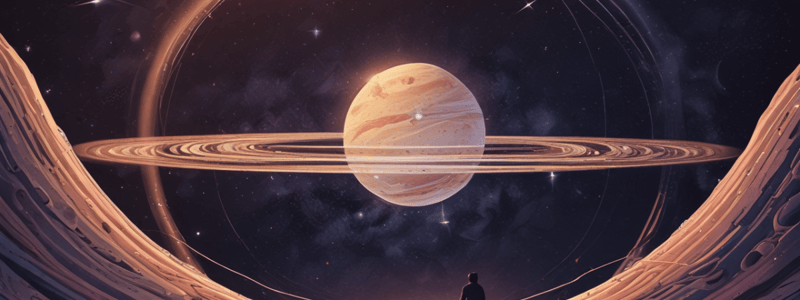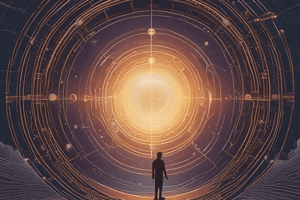Podcast
Questions and Answers
What is the primary cause of the tides?
What is the primary cause of the tides?
- The gravitational pull of the sun on the oceans
- The rotation of the Earth on its axis
- The gravitational pull of the moon on the oceans (correct)
- The wind that blows on the surface of the oceans
What is the main reason for the changing seasons on Earth?
What is the main reason for the changing seasons on Earth?
- The Earth's orbit around the sun
- The tilt of the Earth's rotational axis (correct)
- The movement of the Earth's magnetic field
- The changes in the sun's energy output
What is the solar wind made up of?
What is the solar wind made up of?
- Uncharged particles
- Gaseous molecules
- Liquid droplets
- Charged particles (correct)
What is the result of the tidal locking between the Earth and the moon?
What is the result of the tidal locking between the Earth and the moon?
What is the term for the wobble of the Earth's axis over a period of 26,000 years?
What is the term for the wobble of the Earth's axis over a period of 26,000 years?
What is the approximate tilt of the Earth's axis in its orbit around the sun?
What is the approximate tilt of the Earth's axis in its orbit around the sun?
What is the effect of the solar wind on the Earth's electronics?
What is the effect of the solar wind on the Earth's electronics?
What is the term for the periodic changes in the sun's energy output?
What is the term for the periodic changes in the sun's energy output?
What causes the moon to remain in its orbit around the Earth?
What causes the moon to remain in its orbit around the Earth?
What is the phase of the moon called when none of the moon's lit side is visible from Earth?
What is the phase of the moon called when none of the moon's lit side is visible from Earth?
Which description best explains a solar eclipse?
Which description best explains a solar eclipse?
Which factor primarily causes the Earth to orbit the sun?
Which factor primarily causes the Earth to orbit the sun?
Why do we not always see half of the moon lit up from Earth?
Why do we not always see half of the moon lit up from Earth?
What natural phenomena on Earth are influenced by the positions of the sun, moon, and Earth?
What natural phenomena on Earth are influenced by the positions of the sun, moon, and Earth?
What term describes the specific arrangement of the moon, Earth, and sun that results in periods when the entire sphere of the moon is visible from Earth?
What term describes the specific arrangement of the moon, Earth, and sun that results in periods when the entire sphere of the moon is visible from Earth?
Flashcards are hidden until you start studying
Study Notes
Interaction of Earth, Moon, and Sun
- The sun, earth, and moon interact through a complex system of motions and forces due to their masses.
- The moon orbits the earth once per month, and the earth orbits the sun once per year.
- The earth's gravitational pull keeps the moon in orbit, and the sun's gravitational pull keeps the earth in orbit.
Geometry: Phases and Eclipses
- The sun always illuminates half of the earth and half of the moon, with the other side of each object in shadow.
- The phases of the moon depend on the relative positions of the earth, moon, and sun:
- New moon: moon is between the sun and the earth, with the lit half facing away from the earth.
- Full moon: moon is on the far side of the earth, with the entire lit sphere visible.
- Half moons and crescent moons: intermediate phases between new and full moon.
- A solar eclipse occurs when the moon is positioned perfectly between the earth and sun, blocking the sun's disk.
Tides and Forces
- The gravitational pull of the moon and sun on the earth's oceans causes the tides.
- The moon has a greater effect on the tides due to its closer proximity to the earth, while the sun's effect is about half as strong.
- The periodic rising and falling of the oceans occur each day due to the moon's gravitational pull.
Sunlight, Seasons, and Solar Winds
- The sun provides energy for life on earth through sunlight.
- The earth's tilted rotational axis causes seasonal changes:
- Summer in the Northern Hemisphere: earth is tilted towards the sun, resulting in more concentrated sunlight.
- Winter in the Northern Hemisphere: earth is tilted away from the sun, resulting in less concentrated sunlight.
- The sun's activity varies on an eleven-year cycle, affecting the amount of energy received by the earth.
- The solar wind is a wind of charged particles that interacts with the earth's magnetic field, causing the aurora borealis.
Long-Term Interactions
- The earth, moon, and sun are not always in the same arrangement, with changes occurring over thousands and millions of years.
- The moon is tidally locked with the earth, with the same side always facing the earth.
- The earth's tilt changes over time, with a tilt angle that varies by 2.5 degrees and a wobble (precession) that takes 26,000 years to complete.
Studying That Suits You
Use AI to generate personalized quizzes and flashcards to suit your learning preferences.




